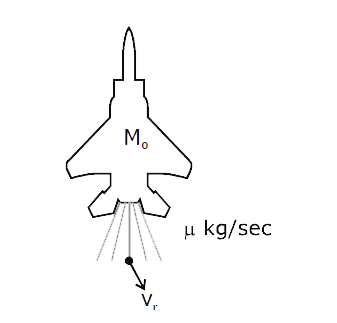A rocket accelerates sraight up by ejecting gas downwards. In a small time interval Δt, it ejects a gas of mass Δm at a relative speed μ. Calculate KE of the entire system at t+Δt and t and show that the device that ejects gas does work = (12)Δmμ2 in this time interval (neglect gravity).Solution in Punjabi
Step by step video & image solution for A rocket accelerates sraight up by ejecting gas downwards. In a small time interval Deltat, it ejects a gas of mass Deltam at a relative speed mu. Calculate KE of the entire system at t + Deltat and t and show that the device that ejects gas does work = (1/2)Delta mmu^2 in this time interval (neglect gravity). by Physics experts to help you in doubts & scoring excellent marks in Class 11 exams.
Updated on:21/07/2023Topper's Solved these Questions
Similar Questions
Can mechanical waves travel through vacuum?
View SolutionAt a certant of time the mass of a roket going up vertically is 100kg. If it is ejecting 5kg of gas per second at a speed of 400m//s , the acceleration of the rocket would be ("talking" g=10m//s^(2))
View SolutionA rocket accelerates straight up by ejecting gas downwards. In a small time interval Deltat , it ejects a gas of mass Delta m at a relative speed u . Calculate KE of the entire system at t+Deltat and t and show that the device that ejects gas does work =((1)/(2))Delta m . u^(2) in this time interval (neglect gavity).
View SolutionA 5000 kg rocket is set for verticle firing the relative speed of burnt gas is 800ms^(-1) To give an initial upwards acceleration of 20ms^(-2) the amount of gas ejected per second to supply the needed thrust will be
View SolutionA 500 kg rocket is set of vertical firing. The relative speed of burnt gas is 800ms^(-1) To give an initial upwards acceleration of 20ms^(-2) , the amount of gas ejected per second to supply the needed thrust will be
View SolutionSuppose a rocket with an intial mass M0 eject a mass Δm in the form of gases in time Δt, then the mass of the rocket after time t is :-
View SolutionIf rocket engine ejects fuel at the rate μ kg/s with relative velocity vr. At time t = 0, speed of rocket is u. Consider the value of acceleration due to gravity is constant and equal to g.

If rocket is in gravity free space then find velocity of rocket as function of time.
View SolutionA rocket in space is being propelled by the ejection of a gas. What is the velocity of the centre of mass of the rocket-fuel system?
View SolutionA rocket is ejecting a mass m of gases per unit time with velocity V relative to the rocket, the thrust on the rocket is:
View SolutionA rocket burns 50g of fuel per second ejecting it as a gas with a velocity of 5 xx 10 cm s^(-1) . What force is exerted by the gas on the rocket?
View SolutionA rocket accelerates straight up by ejecting gas downwards. In a small time interval Δt, it ejects a gas of mass Δm at a relative speed u . Calculate KE of the entire system at t+Δt and t and show that the device that ejects gas does work =(12)Δm.u2 in this time interval (neglect gavity).
View SolutionA rocket burns 50g of fuel per second ejecting it as a gas with a velocity of 5 xx 10 cm s^(-1) . What force is exerted by the gas on the rocket?
View SolutionA rocket accelerates straight up by ejecting gas downwards . In small time interval Deltat , it ejects a gas of mass Deltam at a relative speed u . Calculate kE of the entire system at t+Deltat and t and show that the device that ejects gas does work = (1/2) Delta"mu"^(2) in this time interval (negative gravity ).
View Solutionएक रॉकेट नीचे की ओर गैस निष्काषित करता हुआ सीधा ऊपर को त्वरित होता है। यह एक अल्प समय Δt में, Δm द्रव्यमान गैस, सापेक्ष वेग u से निष्काषित करता है। संपूर्ण निकाय की K.E., t +Δt एवं tक्षण पर परिकलित कीजिए और दर्शाइए कि इस समय अंतराल में गैस निष्कासित करने वाली युक्ति = (1/2)Δmu2 कार्य करती है। (गुरुत्व की उपेक्षा कर सकते हैं)
View SolutionA rocket burns 0.2 kg of fuel per second and ejects it as a gas with velocity of 10 km/s. Calculate the force exerted by the ejected gas on the rocket.
View Solution

